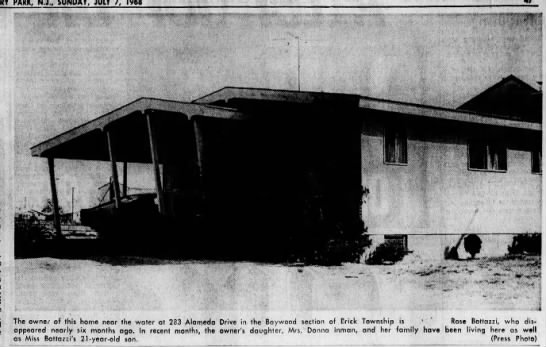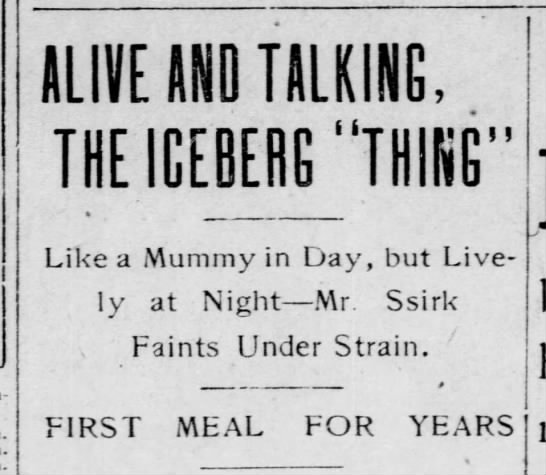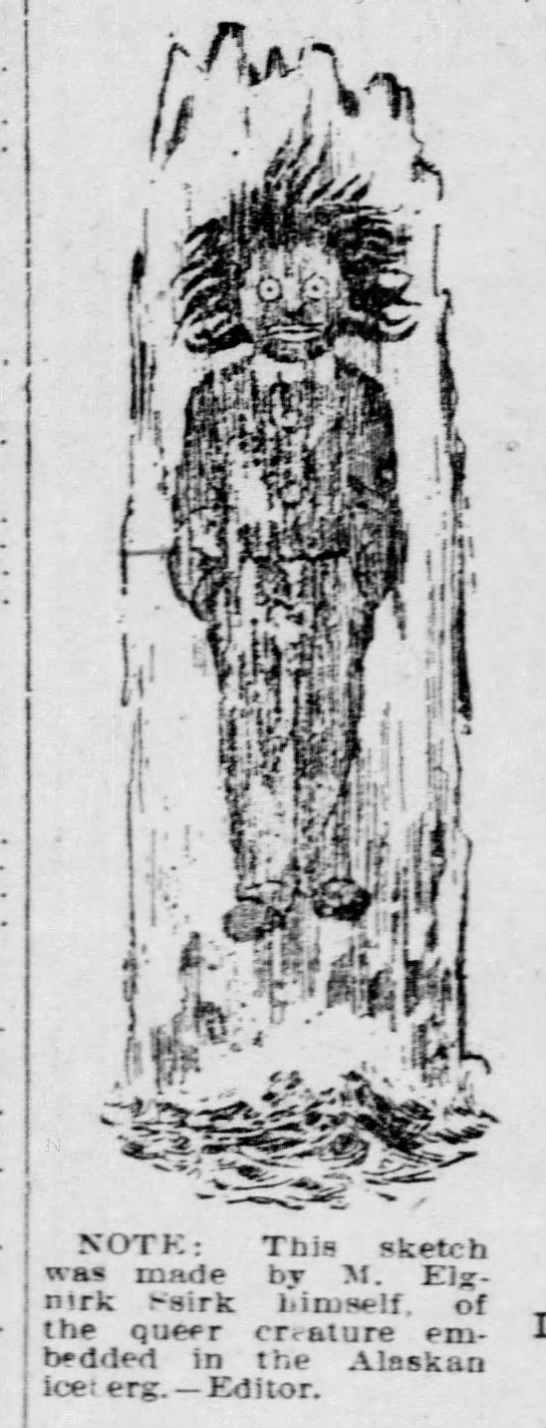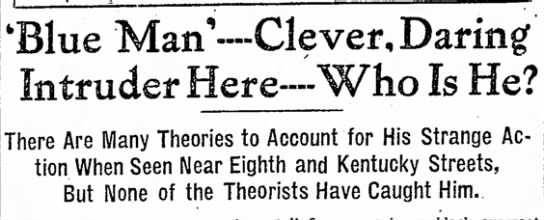 |
| Louisville Courier Journal, January 18, 1921, via Newspapers.com |
Ah, Louisville, Kentucky. Famed for the Kentucky Derby, Muhammad Ali, Kentucky Fried Chicken, Louisville Slugger baseball bats, blue quasi-humans roaming the streets…
If you are at all familiar with my blog, you can guess which of the above we will be discussing this week.
The saga of Louisville’s most unusual tourist was first covered in the “Courier Journal” on January 17, 1921, although sightings of the entity which became known as the “Blue Man” had been taking place for some time. In the newspaper’s front-page (!) story on the mystery, one Reese Carrell told a reporter of his encounter with the stranger: “I’ve only been knocked down once in my life, and it did it. It’s been around here every night for the last two weeks. What it’s after, I don’t know. But one night last week when I came home at about 11 o’clock, I saw somebody standing on our front step. I thought it was my father, and I walked right up to him. ‘Looking for the Blue Man, Pop?’ I asked him, and just then, he hit me in the chest. I was knocked against the fence, and when I got up it was gone.” Carrell described the “Blue Man” as extremely tall, and, yes, with a face of a pleasing indigo hue.
The following day, the “Courier Journal” reported on Mrs. Earl Schubnell’s encounter with the being on the previous Thursday evening. She said she was sitting where she could see into her kitchen when she heard the shutter of one of the windows rustling, after which a hand was thrust through a broken pane in the window.
“The hand caught hold of the curtain and pulled it back,” said Mrs. Schubnell. “But when I screamed, it was withdrawn quickly and I heard the sound of someone running out of the alley and down the street in the direction of Kentucky Street.” In contrast to Carrell’s description, Mrs. Schubnell said the hand was “large and white,” one that was impossible to belong to any “blue man.”
A man named Virgil Hobbs claimed to have seen the figure wandering the streets on several occasions. The first time he spotted the Blue Man, a neighbor named Walter Fogel took a shot at it.
“As he shot,” said Hobbs, “I saw a tall figure wearing a black overcoat and a black soft hat climb over the coal shed at the rear of the Fogel yard and disappear into the night.”
Hobbs added, “Five minutes later, when a crowd had gathered in front of the house, I saw a man who, as I remember, looked suspiciously like the figure I had just seen to disappear, walking leisurely down Eighth Street. The man stopped and inquired about the excitement, and when told by one of those standing by, laughed and passed on. On the three other occasions that the intruder was scared off, the stranger passed by and each time the man, who was white and weighed about 180 pounds, wore the same black overcoat and black hat.” Hobbs marveled that the man had so far eluded capture, as on the second night of his appearance the Fogel house was “surrounded by fifteen patrolmen, five detectives and two members of the military force.”
Adding to the strangeness of the whole business is that no one had any idea what the “Blue Man” was trying to accomplish. Louisville residents could only speculate that he--or it--had “iron nerve, no brains, or an irresistible desire to obtain possession of a thing, or things unknown.”
On January 19, the nightly hunt for the “Blue Man” took an unexpected turn. Two detectives standing guard at Eighth and Kentucky Streets saw a man named Stewart Graven walking by carrying a suitcase and a bundle. Their suspicions aroused, the policemen followed Graven to his home. After he had entered, the detectives knocked on the door and politely forced their way inside. The residence, they reported, “looked like a storeroom,” full of expensive goods of all kinds. When questioned, Graven confessed to stealing a large quantity of items from the American Railway Express Company.” He said his only motive for the thefts was that he was out of work, and could not let his wife and small child starve. He was charged with grand larceny and two charges of stealing from a common carrier. There was speculation that Graven was also the elusive “Blue Man,” a theory which made the prisoner laugh. “Me the ‘Blue Man’?” he told reporters. “I wish I was. If I was I wouldn’t be in here right now!”
Despite this sad distraction, the Blue Man continued his rounds. One night, Mrs. Emma Perkins heard “whisperings” outside her home. She investigated, but saw nothing. The following night, she saw someone peeping into her window. However, by the time she opened the door, no one was to be seen. Several days later, on January 20, someone raised a window in the apartment of Stewart Friend, who boarded with Mrs. Perkins. Grabbing his revolver, he ran to the window and shot at a figure standing just a few feet away. He saw “it” fall against the fence. Mrs. Perkins ran out with her gun and also fired at the intruder. Both were positive they had pumped “it” full of lead. Eerily enough, however, when the area was inspected, all that was found was a few bullet holes in the fence. No blood, or any other trace of the “Blue Man” was found.
The following night, Mr. Blue took to letter-writing. Around 9:30 p.m., one Henry Etzel heard a light knocking on his door. This was strange, as the gate in front of his home always creaked when opened, and he had not heard it do so. He had also not heard any footsteps in the adjoining alleyway. When he opened the door, no one was there.
Assuming his ears had played tricks with him, Etzel went back to his newspaper. A couple of minutes later, he heard more knocks, louder than before. He dashed to the door and threw it open. He still saw no one.
There was nothing for it but to return to reading, but he stayed wary. Then, someone or something kicked the door several times. Etzel was able to open it before the noise ceased, but he still failed to see anyone. All he found outside his door was a note reading, “I will call again. Don’t be afraid. Your friend, the ‘Blue Man’ till we meet again.”
On the night of the 22nd, Mrs. L.I. Dilly heard someone trying to force open her apartment door. She ran to her neighbor, Mrs. G.S. Spalding, to sound the alarm. Mrs. Dilly then went out a side door and to the back of their residence. She saw a man jump over the back fence.
When police were summoned, they could find nothing, not even a footprint in the soft ground. Fifteen minutes after the policemen left, Mrs. Dilly, who was back in bed trying to go back to sleep, heard footsteps. Again, she heard someone turning her doorknob and pressing against the door. The intruder gave up on the door and retreated. A moment later, Mrs. Dilly saw a shadow on her window. And then, a face was pressed against the glass.
Mrs. Dilly grabbed her gun and ran outside. Seeing a figure fleeing into the night, she shot at it. Once again, prowler managed to escape. For the second time that night, the police fruitlessly searched the vicinity for footprints.
Immediately after Mrs. Dilly retired to bed, she had to call the police for a third time. She told the policemen that as she was drawing the covers about her, she heard a faint noise. She clutched her gun, waiting for whatever might happen next. The shadowy face returned to her window. She and Mrs. Spalding ran to the side yard, and Mrs. Dilly again fired at the prowler. This time, she heard a moan of “Oh, oh!”
She got the Blue Man at last!
However, when the police arrived they once again found...not one damn thing. No footprints, no blood. If the Blue Man was
not a ghost, it did a very fine imitation of one.
Early on the morning of January 23, Mrs. J.G. Crider was awakened by her telephone ringing. When she answered, she heard a strange, husky voice saying, “The ‘Blue Man.'..last seen Eighth and Walnut!” Then the caller hung up. Police, as usual, found no clues to this latest bit of Blue Man Eccentricity.
On the night of the 29th, Blue Man entertained himself by ringing doorbells. At 9 p.m., Mr. and Mrs. E.O. Mershon phoned police complaining of hearing “three different kinds of strange noises” around their house. First, the bell was rung several times. That was followed by noises like snow sliding off the roof “only it wasn’t.”
Then, Mrs. Stanley Searcy reported that her doorbell had been ringing almost continuously from dusk to 11 p.m. It was, she said indignantly, the third night in a row she had been pestered with incessant ringing. Although she stood watch from her window, she saw or heard no one. Just the ringing.
The police, the “Courier Journal” sighed, “passed a restless evening.”
By early February, it seemed that the “Blue Man” had acquired a distaff sidekick. Several female residents of the Richter Apartments at Fourth and Oak Street reported being frightened by the appearance of someone wearing a blue coat suit and a large black hat. This person would knock on doors asking for a glass of water, in a manner the women found very unnerving. Although the visitor was wearing female clothing, the “large physique” made the alarmed residents believe it was probably a man.
Later that month, newspapers reported that a member of the Fogel family bedridden by illness was being pestered every night by a face “blue and terrible” pressed against the pane of his window. “It has been shot at and the bullets struck thin air. When the image appeared members of the family run to the outside, but never have seen anything more than darkness.”
When the family consulted a fortune teller, she told them that when the “thing” got what it wanted, it would go away.
What
did it want? She couldn’t say.
Reese Carrell’s name returned to public print. He told reporters that the “Blue Man” had been hanging around his home for days. One night, it even crept into the Carrell home and stole a pair of trousers. Reese shot at the intruder several different times, with the usual failure. Doubting the efficacy of his son’s aim, Reese’s father tried shooting at the stranger. “I never missed a rabbit or a bird in my life,” Mr. Carrell complained, “but the shots went right through him.” When asked if he thought the intruder was a ghost, Carrell Sr. retorted, “Ghost? What would a ghost want with my pants?” One night, a patrolman fired no less than seven shots at close range without causing the slightest effect on the “Blue Man.”
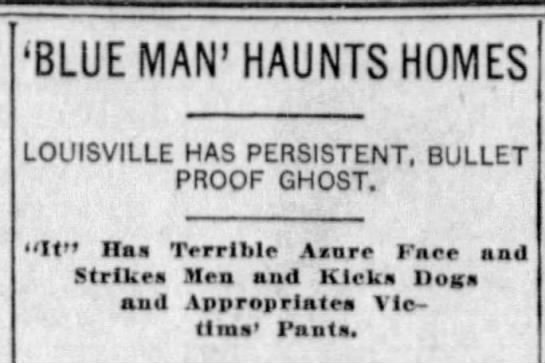 |
| Kansas City Star, January 22, 1921 |
As they say, all good things come to an end. Such was the case with our “Blue Man.” Whether he feared being caught at last, or simply got bored with his capers, by the end of March, the story disappeared from the newspapers. The “Blue Man” was evidently never captured, and the motive--if there ever was one--behind his activities remained a mystery.


